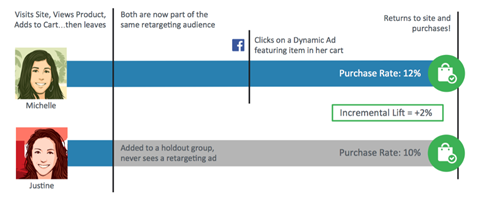Incremental Sales: What You Need to Know for the Best Outcomes

No matter the type of business you run, you will need to pay attention to multiple factors to evaluate your marketing campaigns, which can result in incremental sales. While the idea of incremental sales may seem straightforward at a glance, there is more to it than meets the eye.
What Is Incremental Sales? What Is Incrementality?
Incremental sales refer to the sales lift you see from a promotion or marketing campaign compared to your average baseline. In other words, it is the additional sales that your company had because of a campaign and would not have seen without that campaign.
While that general idea is simple, a key factor is that the leads or sales have to come from outside the company, such as an affiliate, social media ad, influencer, or partner. The distinction is that without the help of that outside influence, your company would not have made the sale.
There is a clear complication when measuring incremental sales. Incrementality refers to sales that happen because of an outside influence, but what if there are multiple outside influences?
Most companies cannot effectively track every single bit of brand awareness that leads to a sale. Because of this, an incremental sale could be associated with multiple efforts and sources. For example, your brand has a brand awareness campaign (TV+DIGITAL) and examines the incremental lift in stores (offline) – all the data is normalized to support the understanding of those channels’ impact, which does not necessarily make it the last touchpoint.
You can drive incremental sales using a range of marketing activities, such as:
- Digital brand awareness campaigns (e.g. YouTube, Facebook, Snapchat)
- Owned media (e.g. blogs, videos, written content)
- DTC/Conversion-based activities
- Content created by an influencer or affiliate on social media
The terms incrementality and incremental sales are frequently used somewhat interchangeably.
What Is Incremental Profit?
Incremental profit is closely tied to incremental sales, but it measures the net profit. So, incremental profit would be your incremental sales minus your marketing expenditures or other efforts to increase those sales.
How to Calculate Incremental Sales
Now that you understand incrementality, you need to learn how to calculate incremental sales. The standard is to measure it based on your new customers or the increase in AOV (average order value) of your existing ones. You can define a new customer however you want. Some companies will count anyone who has not made a purchase within a year (or a different time period) as “new”, while others will only count first-time buyers. It is your decision and depends on your goals.
Measuring incremental sales can be done in several ways. One of the most popular is to assign a unique link or code to sales from a particular source or ad campaign. The simplest example of this would be providing affiliates with unique links and counting the number of new customers you get via each link.
How to Measure Incrementality
The default marketing measurement when calculating incremental sales is the revenue or dollars of products sold. You can also choose to measure the number of products sold or the number of new customers.
You can also use a range of KPIs to help measure incrementality and incremental sales. However, this is less common than dollars or new customers. Other marketing measurement options include click-through rates, subscriptions to emails or newsletters, conversions from landing pages, and more.
These are perfectly valid metrics to measure and use in incremental sales, especially if you want to track offline sales and, therefore, do not have access to the same type of data as online sales.
Measuring These Other Types of Data
The key takeaway is that incremental sales is an adaptable figure, and if you cannot track the data you would like to, there are alternatives.
One popular option is completing a brand lift study. This could involve hiring a third party to conduct a survey regarding your brand awareness before your campaign and then again after it. Then, you would compare the figures from that campaign with the same equations for incrementality and incremental sales mentioned below.
Just be aware of the restrictions on what your new data will tell you.
For example, if you measure how many people subscribe to your newsletter thanks to an in-store promotion, you will not know how many of those people go on to make repeat purchases in-store. You could overcome this with a loyalty program of some sort, but that does not appeal to all customer bases.
The Basic Formula – How to Calculate Lift in sales
The simplest way to measure incrementality is to subtract the number of sales you would have had, known as your baseline sales, from those that you did have during a given marketing campaign:
Incremental Sales = Total Sales – Baseline Sales
You can also find sales lift calculators online.
Determining Baseline Sales
For many companies, the biggest challenge is determining what the sales would have been without the campaign, which is called the baseline sales. You will likely need to have plenty of data on hand to get this figure. Most companies should already have an idea of their baseline sales, as this is a key part of budgets and conversations with investors.
You can use a few different strategies to determine the baseline sales figure to use when calculating incremental sales:
- Sales figures from immediately before the promotion
- Sales figures from the same time the previous year
- Your predicted sales based on a combination of the above factors
How to Calculate Sales Lift Percentage for Retargeting
Another common calculation used in a sales lift analysis is a percentage, especially for purchases made following retargeted ads. In this situation, you would divide your previous customers into two groups. One serves as a control and does not receive retargeted ads, while the other does receive retargeted ads. This is referred to as incrementality testing.
You would then track how many people in each group make new purchases. If 10% of the people who do not see retargeted ads make a purchase and 12% of those with retargeted ads make a new purchase, your incremental lift would be 2% (12% minus 10%).
Incremental Lift = Retargeted Repurchases – Control Repurchases
The following is a visual representation of this calculation:

Image Source: https://www.nanigans.com/2017/07/24/incrementality-the-key-to-measuring-advertising-effectiveness/
To get a percentage of incrementality, you want to know how much of a difference the retargeted ads had. This formula would be:
Incrementality = (Retargeted Repurchases – Control Repurchases) / Retargeted Repurchases
In the example, your incrementality would be 16.7% (12%-10%=2%, which is divided by 12%).
Why Do You Need to Understand the Incremental Value of Your Activities and Its Effect on Brand Lift?
Understanding the value of incremental sales or conversions is important because it helps ensure you are spending your marketing budget efficiently. For example, by comparing your brand lift from working with different affiliates, you could see which are doing the best.
Or you may discover that you are wasting your marketing budget on some methods. For example, what if your calculation shows that affiliates do not have a significant contribution? You could be spending money on commissions that do not necessarily help you get sales.
On the other side of the spectrum, you may realize that some methods lead to high incrementality, so you should spend more on them. If you have a lot of brand lift from affiliates, for example, then you might consider expanding your affiliate program.
The bottom line is that knowing your incremental sales helps you plan how to use your marketing budget more effectively and provides perspective. By calculating your sales lift, you have a figure that compares your results to what they would have been without the marketing campaign instead of a raw figure.
How to Quantify Marketing Efforts
Measuring marketing attribution typically involves using KPIs, such as conversion rates, website visits, or bounce rates. While all of these are important, quantifying your marketing success with incremental sales offers a direct look at their impact on your bottom line – whether your sales are online, offline, or both.
When it comes down to it, this is among the best ways to quantify marketing efforts.
An Example of Incrementality
To show how incremental sales provides better context than raw numbers, consider the following scenario. You spend $5,000 on an affiliate marketing program for a product, and this leads to $15,000 in sales. At face value, it seems that your affiliate marketing campaign gave you $10,000 in profit or ROI.
But you did not account for how much of that product you already sold. If you previously only sold $6,000 worth, then you have incremental sales of $9,000 (sales of $15,000 minus baseline sales of $6,000). You know it is a sound strategy and should continue to invest in that campaign. On the other hand, if you do not add tracking to the equation, you will have to try and isolate the different variables (efforts, campaigns, etc.).
But what if you already sold $11,000 of that product? The incremental sales would be just $4,000 (sales of $15,000 minus the baseline sales of $11,000). Given that you invested $5,000, you lost money. This would let you know you should reconsider using that particular marketing campaign.
Gathering More Data
All of the reasons to calculate incrementality or incremental sales come down to one main benefit – gathering more data. You need data to help adjust your marketing strategies and other efforts. Incrementality is just one example of sales data. Other important data categories include activity data, such as the actions your team takes to boost sales, and observational data, such as the in-store conditions that seem to affect sales.
The Bottom Line
Incrementality or incremental sales refers to the increased amount of sales that you have thanks to an external effort, such as an affiliate program or pay-per-click campaign. For simplicity and easier tracking, it is most common for incremental sales to focus on the last interaction a customer has before buying.
With your incremental sales data, you can see which marketing campaigns are performing the best and the worst. This lets you focus your marketing budget on those with the best ROI.



















